|
|
|
Sort Order |
|
|
|
Items / Page
|
|
|
|
|
|
|
| Srl | Item |
| 1 |
ID:
149500


|
|
|
|
|
| Summary/Abstract |
MIROSLAV NINCIC and MATTHEW WEISS argue that conflict over access to fresh water could threaten the future of international security. They examine conditions under which such conflict may arise in the Middle East and South Asia. The authors identify countries most at risk for water-related conflict and propose policy recommendations to mitigate for these risks.
|
|
|
|
|
|
|
|
|
|
|
|
|
|
|
|
| 2 |
ID:
129466
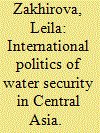

|
|
|
|
|
| Publication |
2013.
|
| Summary/Abstract |
The article examines the international politics of water security in Central Asia with a particular focus on the level of regionalism. Are the five Central Asian states evolving into a region capable of solving water management problems on a regional basis? To examine the extent to which water has shaped the structure of Central Asian relations, I use water-related events. The empirical findings suggest that international relations of the Central Asian states are characterised by at least two sets of triads rather than a singular region. The presence of regional fragmentation is likely to exacerbate existing disputes over water and possibly destabilise the region.
|
|
|
|
|
|
|
|
|
|
|
|
|
|
|
|
| 3 |
ID:
125303
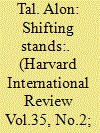

|
|
|
|
|
| Publication |
2013.
|
| Summary/Abstract |
While the Middle East is frequently in the news because of political volatility and violence, there is an underlying lack of environmental equilibrium that poses a comparable threat to regional stability. Israel's neighbors--Egypt, Jordan, and Palestine--are arid countries with limited natural carrying capacity and burgeoning populations. Providing food and employment in what were traditionally agrarian economies has contributed to significant depletion of soil and water resources. Israel's experience as an innovator in technologically intensive dryland agriculture and forestry is entirely different. Yet it is not clear whether the grand Israeli experiment in water management and combating of desertification offers a compelling alternative model to its neighbors should diplomatic breakthroughs pave the way for transboundary cooperation. Not only are the socioeconomic and cultural circumstances entirely different, but the sustainability of some of Israel's unique management practices remains questionable.
|
|
|
|
|
|
|
|
|
|
|
|
|
|
|
|
| 4 |
ID:
082663
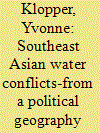

|
|
|
|
|
| Publication |
2008.
|
| Summary/Abstract |
This article analyzes water-related conflicts in Southeast Asia and draws the attention to controversial dam-and hydropower-schemes. It focuses on three dam projects in Thailand, Laos and Burma that are all interwoven by different characteristics of development assistance. But they also slightly differ in terms of the implementation stage, the geopolitical setting, the socio-economical frameworks and the actors involved. Against this analytical background, the approach unveils the complexity of internationalising conflicts that are created under the influence of the ongoing globalisation and by multiple actors involved, their networks, strategies and power relations. "Scarcity of resources-securing energy by development assistance" provides a brief introduction by drawing the main global configurations. "Energy supply and poverty alleviation-new dams in Southeast Asia" zooms in on the specific stage by mirroring dam disputes in Southeast Asia (SEA). Based on these fundamentals, in "Different dams-diverse actors and conflict potentials" the case studies are reconstructed to highlight the multiplicity of dam-projects and inherent controversies. "Conclusion-new conflict frameworks require new instruments of dispute resolution" offers an outlook on conceptual ideas on how to deal with future dam disputes under the auspices of development assistance
|
|
|
|
|
|
|
|
|
|
|
|
|
|
|
|
| 5 |
ID:
117911
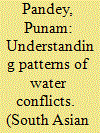

|
|
|
|
|
| Publication |
2011.
|
| Summary/Abstract |
The article underlines the importance of water as a resource which is very unevenly distributed on Earth. Asia is a water deficit region in which 36 per cent of Earth's water is available for 60 per cent of the world's population. The disturbing aspect is how water's unequal distribution, spatially as well as temporally, engenders different kinds of conflicts in the region. In some cases, water becomes a latent factor in causing other conflicts. The conflicts over resources, particularly over water, are couched in different dimensions of politics. The article discusses various types of water conflicts and argues about the limitations of the managerial approach to the understanding of water conflicts. There is a need to deconstruct the social dimension of water usage and the politics behind its sharing at all levels.
|
|
|
|
|
|
|
|
|
|
|
|
|
|
|
|
| 6 |
ID:
140305
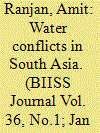

|
|
|
|
|
| Summary/Abstract |
Water conflict in South Asia is one of the critical challenges for the region. The unitary irrigation system constructed since Mughal period was divided in 1947, when the sub-continent was partitioned into India and Pakistan. Not enthusiastic to break the then existing hydrological, railway and port systems, Sir Cyril Radcliffe took ‘other factors’ also into consideration and not only religion as a sole determinant to partition the sub-continent. Despite his efforts, the water bodies were divided between the two arch enemies. Soon after the partition, the conflicts over shared water bodies started and have been graduated over the decades. The political animosities among the South Asian neighbours have inflamed the water conflicts further. As a result, arrangements, agreements and treaties seeking cooperation over shared water resources have failed to address water related grievances of each country. One common allegation the neighbouring countries have is that India exploits their resources for its own use. This allegation helps the radical elements from those countries to espouse the causes and raise the cries of water nationalism. Not only in those countries, the feeling of ‘sovereign’ rivers is also strong in India. The political tensions over water are duly aided by the growing supply-demand gap, phenomenon of climate change and predominant use of supply-side management system. Though the water conflicts are bilateral, it has regional implications. Realising this fact, in most of the regions, the regional organisations have taken steps to mitigate differences among the riparian states and have helped them to enter into a cooperative arrangement. In South Asia, this is difficult to attain because the South Asia Association for Regional Cooperation (SAARC) is not a very effective body.
|
|
|
|
|
|
|
|
|
|
|
|
|
|
|
|
| 7 |
ID:
134054
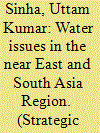

|
|
|
|
|
| Publication |
2014.
|
| Summary/Abstract |
With water concerns growing increasingly urgent, the global community will benefit from a treatment of the lessons learned and best practices in water dispute resolutions and approaches to water management. This report discusses the outcome of a working group of water experts from the Near East and South Asia (NESA) region,1 set up by the Strategic Studies Network, National Defense University, Washington DC. It is hoped that the findings and agreed-upon recommendations will add to the body of knowledge and sensitise policy-makers and governments to the challenges and opportunities that water presents. Some of the key questions discussed are:
|
|
|
|
|
|
|
|
|
|
|
|
|
|
|
|
| 8 |
ID:
125297
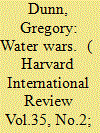

|
|
|
|
|
| Publication |
2013.
|
| Summary/Abstract |
Water seems an unlikely cause of war, but many commentators believe it could define 21st Century conflict. A February 2013 article in U.S. News and World Report warns that "the water-war surprises will come", and laments that "traditional statesmanship will only take us so far in heading off water wars". A 2012 article in Al Jazeera notes that "strategists from Israel to Central Asia" are preparing for strife caused by water conflict. Even the United States National Intelligence Estimate predicts wars over water within ten years. Their concern is understandable--humanity needs fresh water to live, but a rise in population coupled with a fall in available resources would seem to be a perfect catalyst for conflict. This thinking, although intuitively appealing, has little basis in reality--humans have contested water supplies for ages, but disputes over water tend to be resolved via cooperation, rather than conflict. Water conflict, rather than being a disturbing future source of conflict, is instead a study in the prevention of conflict through negotiation and agreement.
|
|
|
|
|
|
|
|
|
|
|
|
|
|
|
|
|
|
|
|
|